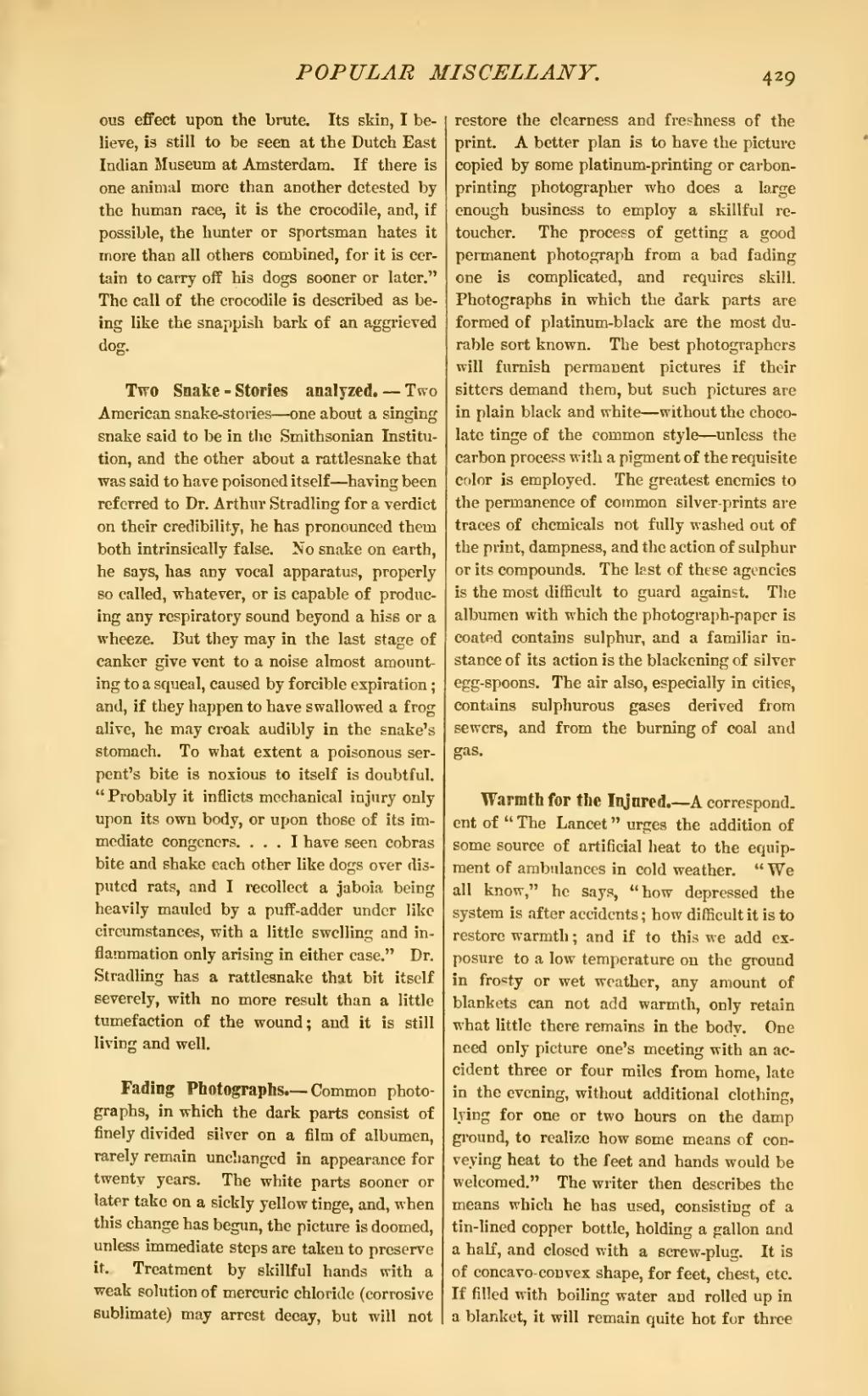ous effect upon the brute. Its skin, I believe, is still to be seen at the Dutch East Indian Museum at Amsterdam. If there is one animal more than another detested by the human race, it is the crocodile, and, if possible, the hunter or sportsman hates it more than all others combined, for it is certain to carry off his dogs sooner or later." The call of the crocodile is described as being like the snappish bark of an aggrieved dog.
Two Snake-Stories analyzed.—Two American snake-stories—one about a singing snake said to be in the Smithsonian Institution, and the other about a rattlesnake that was said to have poisoned itself—having been referred to Dr. Arthur Stradling for a verdict on their credibility, he has pronounced them both intrinsically false. No snake on earth, he says, has any vocal apparatus, properly so called, whatever, or is capable of producing any respiratory sound beyond a hiss or a wheeze. But they may in the last stage of canker give vent to a noise almost amounting to a squeal, caused by forcible expiration; and, if they happen to have swallowed a frog alive, he may croak audibly in the snake's stomach. To what extent a poisonous serpent's bite is noxious to itself is doubtful. "Probably it inflicts mechanical injury only upon its own body, or upon those of its immediate congeners. . . . I have seen cobras bite and shake each other like dogs over disputed rats, and I recollect a jaboia being heavily mauled by a puff-adder under like circumstances, with a little swelling and inflammation only arising in either case." Dr. Stradling has a rattlesnake that bit itself severely, with no more result than a little tumefaction of the wound; and it is still living and well.
Fading Photographs.—Common photographs, in which the dark parts consist of finely divided silver on a film of albumen, rarely remain unchanged in appearance for twenty years. The white parts sooner or later take on a sickly yellow tinge, and, when this change has begun, the picture is doomed, unless immediate steps are taken to preserve it. Treatment by skillful hands with a weak solution of mercuric chloride (corrosive sublimate) may arrest decay, but will not restore the clearness and freshness of the print. A better plan is to have the picture copied by some platinum-printing or carbon-printing photographer who does a large enough business to employ a skillful retoucher. The process of getting a good permanent photograph from a bad fading one is complicated, and requires skill. Photographs in which the dark parts are formed of platinum-black are the most durable sort known. The best photographers will furnish permanent pictures if their sitters demand them, but such pictures are in plain black and white—without the chocolate tinge of the common style—unless the carbon process with a pigment of the requisite color is employed. The greatest enemies to the permanence of common silver-prints are traces of chemicals not fully washed out of the print, dampness, and the action of sulphur or its compounds. The last of these agencies is the most difficult to guard against. The albumen with which the photograph-paper is coated contains sulphur, and a familiar instance of its action is the blackening of silver egg-spoons. The air also, especially in cities, contains sulphurous gases derived from sewers, and from the burning of coal and gas.
Warmth for the Injured.—A correspondent of "The Lancet" urges the addition of some source of artificial heat to the equipment of ambulances in cold weather." We all know," he says, "how depressed the system is after accidents; how difficult it is to restore warmth; and if to this we add exposure to a low temperature on the ground in frosty or wet weather, any amount of blankets can not add warmth, only retain what little there remains in the body. One need only picture one's meeting with an accident three or four miles from home, late in the evening, without additional clothing, lying for one or two hours on the damp ground, to realize how some means of conveying heat to the feet and hands would be welcomed." The writer then describes the means which he has used, consisting of a tin-lined copper bottle, holding a gallon and a half, and closed with a screw-plug. It is of concavo-convex shape, for feet, chest, etc. If filled with boiling water and rolled up in a blanket, it will remain quite hot for three

